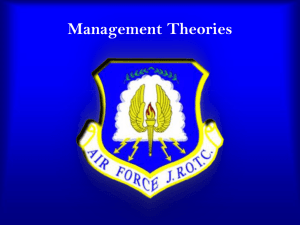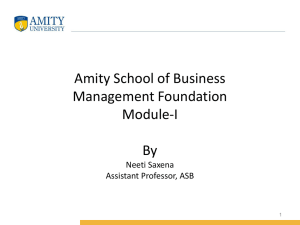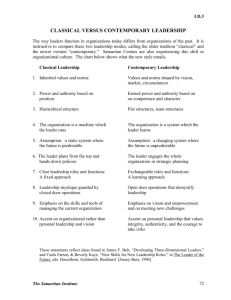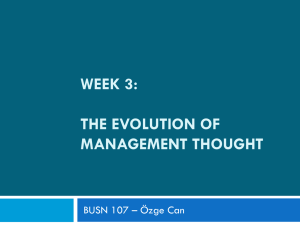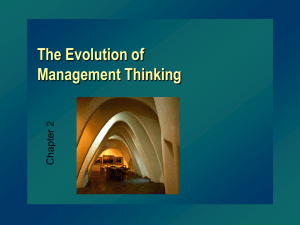Scientific management
advertisement
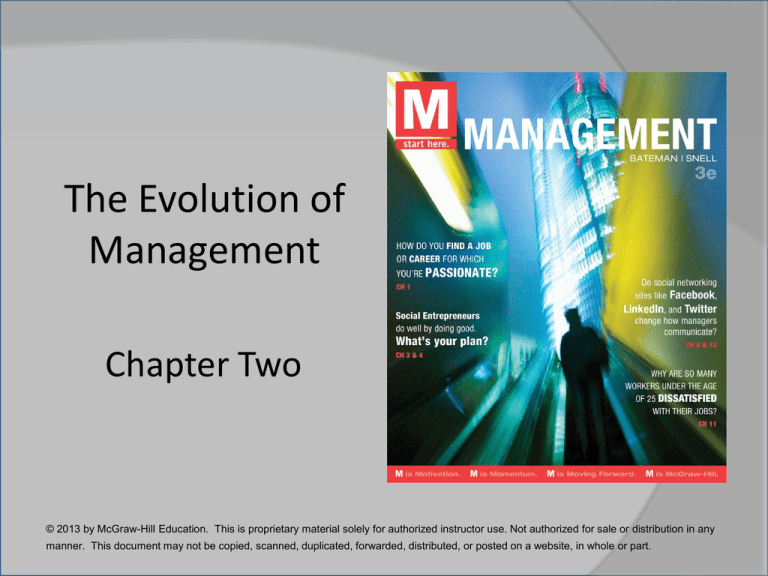
The Evolution of Management Chapter Two © 2013 by McGraw-Hill Education. This is proprietary material solely for authorized instructor use. Not authorized for sale or distribution in any manner. This document may not be copied, scanned, duplicated, forwarded, distributed, or posted on a website, in whole or part. Origins of Management Around 4000 BC, the Egyptians used planning, organizing, leading, and controlling to build their great pyramids; one pyramid took over 100,000 laborers 20 years to complete. As early as 1100 BC, the Chinese applied the managerial concepts of delegation, cooperation, efficiency, organization, and control. 2-3 Origins of Management In 500 BC, Sun Tzu discussed the importance of planning and leading in his book The Art of War. Around 400–350 BC, the Greeks recognized management as a separate art and advocated a scientific approach to work. 2-4 Origins of Management Around AD 1436, the Venetians standardized production through the use of an assembly line In 1776 Adam Smith discussed control and the principle of specialization with regard to manufacturing workers. 2-5 Origins of Management Economies of scale reductions in the average cost of a unit of production as the total volume produces increases 2-6 The Evolution of Management Thought Exhibit 2.1 2-7 Classical Approaches Systematic management a classical management approach that attempted to build into operations the specific procedures and processes that would ensure coordination of effort to achieve established goals and plans systematic management emphasized internal operations because managers were concerned primarily with meeting the explosive growth in demand brought about by the industrial revolution. 2-8 Systematic Management Goals were achieved through: Careful definition of duties and responsibilities. Standardized techniques for performing these duties. Specific means of gathering, handling, transmitting, and analyzing information. Cost accounting, wage, and production control systems to facilitate internal coordination and communications 2-9 Classical Approaches Scientific management a classical management approach that applied scientific methods to analyze and determine the “one best way” to complete production tasks Introduced by Frederick Taylor 2-10 Frederick W. Taylor Frederick Taylor is known today as the "father of scientific management." One of his many contributions to modern management is the common practice of giving employees rest breaks throughout the day. 2.2 Frederick W. Taylor, 1856-1915 11 2-11 Four Principles of Scientific Management 1. Management should 2. Management should develop a precise, scientifically select, scientific approach train, teach, and for each element of develop each worker one’s work to replace so that the right general guidelines. person has the right job. 2-12 Scientific Management 3. Management should 4. Management should cooperate with ensure an workers to ensure appropriate division that jobs match plans of work and and principles. responsibility between managers and workers. 2-13 Scientific Management Henry L. Gantt worked with and became a protégé of Frederick Taylor’s He expanded on the piecerate system by suggesting that frontline supervisors should receive a bonus for each of their workers who completed their assigned daily tasks 2-14 Scientific Management Gantt is also known for creating the Gantt chart, which helps employees and managers plan projects by task and time to complete those tasks. An interesting aspect of the chart is that it illustrates how some tasks need to be done during the same time period. 2-15 Using a Gantt Chart Exhibit 2.2 2-16 Charts: Henry Gantt 2.3 17 2-17 Frank & Lillian Gilbreth Frank and Lillian Gilbreth were prolific researchers and often used their family as guinea pigs. Their work is the subject of Cheaper by the Dozen, written by their son and daughter. Developed the use of motion studies to simply work and improve productive. 2.2 18 2-18 The History of Bureaucratic Management Max Weber, 1864-1920 Proposed the idea of bureaucratic organizations to overcome the problems associated with monarchies and patriarchies. Bureaucracy The exercise of control on the basis of knowledge, expertise, or experience. 3.1 19 2-19 Bureaucracy Bureaucracy A classical management approach emphasizing a structured, formal network of relationships among specialized positions in the organization 2-21 Characteristics of an Effective Bureaucracy Exhibit 2.3 2-22 Administrative Management Administrative management A classical management approach that attempted to identify major principles and functions that managers could use to achieve superior organizational performance 2-23 Administrative Management Henri Fayol, a French mining engineer and executive, published a book summarizing his management experiences. Fayol identified five functions and 14 principles of management. The five functions are planning, organizing, commanding, coordinating, and controlling 2-24 Fayol’s 14 Principles of Management Exhibit 2.4 2-25 Fayol’s 14 Principles of Management Exhibit 2.4 2-26 Administrative Management Chester Bernard-President of New Jersey Bell, author of The Functions of the Executive. Bernard wrote that the extent to which workers willingly cooperate in an organization depends how workers perceive authority and whether they are willing to accept it. He outlined the role of the senior executive: formulating the purpose of the organization, hiring key individuals, and maintaining organizational communications 2-27 Mary Parker Follett Mary Parker Follett is known today as the “mother of scientific management." Her many contributions to modern management include the ideas of negotiation, conflict resolution, and power sharing. 4.1 Mary Parker Follett, 1868-1933 28 2-28 Administrative Management Mary Parker Follett extended Barnard’s work by emphasizing the continually changing situations that managers face. Two key contributions 1. the notion that managers desire flexibility 2. the differences between motivating groups and individuals 2-29 Human Relations Human relations a classical management approach that attempted to understand and explain how human psychological and social processes interact with the formal aspects of the work situation to influence performance 2-31 Human Relations Human relations proponents argued that managers should stress primarily employee welfare, motivation, and communication. Believed that social needs had precedence over economic needs. 2-32 Human Relations Abraham Maslow suggested that humans have five levels of needs. The most basic needs are the physical needs for food, water, and shelter; the most advanced need is for self-actualization, or personal fulfillment. Maslow argued that people try to satisfy their lower-level needs and then progress upward to the higher-level needs 2-33 Maslow’s Hierarchy of Needs Self-Actualization Realizing your potential Esteem Recognition, achievement Belongingness Friendship, social interaction Safety Physical and economic 1.2 Physiological Food and water 34 2-34 Hawthorne Studies: Elton Mayo 4.2 • Workers’ feelings and attitudes affected their work • Financial incentives weren’t the most important motivator for workers • Group norms and behavior play a critical role in behavior at work 35 Human Relations Hawthorne effect people’s reactions to being observed or studied resulting in superficial rather than meaningful changes in behavior 2-37 Contemporary Approaches Sociotechnical systems theory An approach to job design that attempts to redesign tasks to optimize operation of a new technology while preserving employees’ interpersonal relationships and other human aspects of the work A precursor to the total quality management (TQM) movement, it also promoted the use of teamwork and semiautonomous work groups as important factors for creating efficient production systems. 2-38 Contemporary Approaches Quantitative management approach that emphasizes the application of quantitative analysis to managerial decisions and problems A manager makes a decision by developing formal mathematical models of the problem. Typically they use these techniques as a supplement or tool in the decision process, not the primary approach. The limited use of quantitative management is due to managers not being trained in using these techniques. 2-39 Contemporary Approaches Organizational behavior approach that studies and identifies management activities that promote employee effectiveness by examining the complex and dynamic nature of individual, group, and organizational processes 2-40 Contemporary Approaches Douglas McGregor influenced the field of management in the 1960’s with his Theory X and Theory Y perspective. Theory X managers assume workers are lazy and irresponsible and require constant supervision and external motivation to achieve organizational goals. Theory Y managers assume employees want to work and can direct and control them- selves. Theory X is known as a self-fulfilling prophecy. 2-41 2-41 Contemporary Approaches Systems theory A theory stating that an organization is a managed system that changes inputs into outputs • inputs from the outside world, such as raw materials, human resources, and capital. • They transform these inputs into outputs that (ideally) meet the market’s needs for goods and services. • The environment reacts to the outputs through a feedback loop; this feedback provides input for the next cycle of the system. 2-42 Open-system Perspective of an Organization Exhibit 2.5 2-43 Contemporary Approaches Systems approach The contingency perspective refutes universal principles of management by stating that a variety of factors, both internal and external to the firm, may affect the organization’s performance. Therefore, there is no “one best way” to manage and organize because circumstances vary. Situational characteristics are called contingencies. The contingencies include Circumstances in the organization’s external environment. The internal strengths and weaknesses of the organization. The values, goals, skills, and attitudes of managers and workers in the organization. The types of tasks, resources, and technologies the organization uses. 2-44 2-44 Modern Contributors In 2001 Jim Collins authored an influential book titled Good to Great. His research team analyzed 1,435 companies and discovered that great companies are managed by “level 5 leaders” who often display humility while simultaneously inspiring those in the organization to apply self-discipline and selfresponsibility while pursuing high standards. Other exceptional leaders who have left their mark on management practice include Herb Kelleher, cofounder of Southwest Airlines, Sam Walton, founder of Walmart, Jack Welch, Ex-CEO of General Electric, and Lou Gerstner, former CEO of IBM. 2-45 2-45 One of Peter Drucker’s major contributions to the practice of management was the need for organizations to set clear objectives and establish the means of evaluating progress toward those objectives. He was the first person to discuss “management by objective” (MBO), by which a manager should be self-driven to accomplish key goals that link to organizational success. In the Seven Habits of Highly Effective People: Powerful Lessons in Personal Change, Stephen Covey discussed how a leader’s success hinges on balancing between personal and professional effectiveness. 2-46 2-46 Video Case: AFLAC and Dan Amos Why does AFLAC CEO, Dan Amos, want shareholders to vote on his compensation package? What are the consequences of paying an underperforming CEO an exorbitant severance package? 2-47
